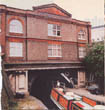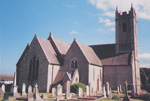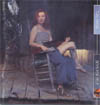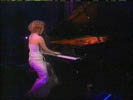|

songs | interviews | photos | tours | boots | press releases | timeline
Tori Amos: timeline
[before] [1963-1968] [1969-1974] [1975-1977] [1978-1983] [1984-1989] [1990-1992] [1993-1994] [1995-1996] [1997-1998] [1999-2000] [2001] [2002-2003] [2004-2005] [2006-2008] [2009-2010] [2011-2013] [2014-2017] [2018-2023] [future & now]
1995 - 1996
1995
* Tori is living in a house on a bridge...
 "Where I live in North London, I live on the canal. And there's this, um, HOLE right underneath the piano, and if you go underneath the canal, in the boats, you can Wave to me and I'll wave back (waves frantically and laughs). And it's really funny because you get, you know, all these Germans who are on the boat touring, and it's like (stern face looking up). And you know, I wave to them back (waves frantically). And they just sit there, it's quite a dizzy. I take all the mail down to the boats, see? Because I live in the little canal house, and I take it down, and it's great, great being the mail girl." [UCLA Speech - February 27, 1995] "Where I live in North London, I live on the canal. And there's this, um, HOLE right underneath the piano, and if you go underneath the canal, in the boats, you can Wave to me and I'll wave back (waves frantically and laughs). And it's really funny because you get, you know, all these Germans who are on the boat touring, and it's like (stern face looking up). And you know, I wave to them back (waves frantically). And they just sit there, it's quite a dizzy. I take all the mail down to the boats, see? Because I live in the little canal house, and I take it down, and it's great, great being the mail girl." [UCLA Speech - February 27, 1995]
*
Tori takes the year off to write and record her third solo album...
"It will take me a year to come up with something nifty," she muses. "I've got to be a real clever little beaver this time. I just want to challenge myself. I'd like to be able to look at it and go 'This blows my socks off.' I think if I could say that, I would be quite satisfied. I don't know if I can blow my socks off. That's my worry. I've got some pretty thick, tight socks on. But we'll see." [Free Music Monthly - August 1994]
February 25, 1995
*
Tori's fourth appearance on The Tonight Show with Jay Leno in Los Angeles. She performs Butterfly, promoting the soundtrack for the John Singleton film, Higher Learning. [click for photos]
February 27, 1995
* Tori Amos gives a lecture on creativity at UCLA. See a video and read a transcript of this event here.
June 1995
 *
Tori begins recording Boys for Pele in a church at Delgany, County Wicklow, Ireland, and a "wonderfully damp Georgian house in County Cork, Ireland," and finishes in studios in Louisiana. "I went back to the house to speak some of my most private thoughts, but I did it with honour. I reclaimed something for myself. These relationships were reflecting in me because of the way things became hidden, which reminded me of the South... It's a very confusing place..." [Making Music - January 1996]
*
Tori begins recording Boys for Pele in a church at Delgany, County Wicklow, Ireland, and a "wonderfully damp Georgian house in County Cork, Ireland," and finishes in studios in Louisiana. "I went back to the house to speak some of my most private thoughts, but I did it with honour. I reclaimed something for myself. These relationships were reflecting in me because of the way things became hidden, which reminded me of the South... It's a very confusing place..." [Making Music - January 1996]
"I chose Ireland rather than Scotland because of the Tuatha de Danann, because although there is a lot of religious control here there is also the memory of something else and a desire for the freedom of the soul." [Hot Press - February 1996]
*
Tori has creative freedom on the record...
Max Hole, managing director of EastWest, said: "She's not someone to whom you have to say, 'I'm not sure about that middle eight,' She does what she wants to do. We had an influence on mixing, as did Ian Stanley, the A&R executive, but really she made the kind of record she wanted to. We allow her the space to do what she wants to." [Billboard - January 13, 1996]
August 22, 1995
*
Tori turns 32.
December 11, 1995
*
Caught a Lite Sneeze is the first single to ever be released for download on the internet before being availabale in stores...
*
Excerpt from Billboard magazine, January 13, 1996:
The first worldwide single, Caught a Lite Sneeze, was posted to Atlantic Records' World Wide Web site December 11, marking one of the first times Internet browsers could play back an entire audio track from a major-label artist before its release.
January 22, 1996

*
Boys for Pele is released in the UK. It is released the next day in the US, and in Japan on February 25. Pele sells 110,000 copies the first week it is released, debuting at #2 on Billboard's album chart, and reaching #1 in the UK.
"Pele was a real turning point for me," she says, adding that both that record and choirgirl hotel were inspired by the lessons of a Native American "medicine woman" she studied with. The singer, who is part Cherokee on her mother's side, credits the Native healer with putting her in touch with the darker side of their nature - and giving her a way to use that energy in her art.
"She basically taught me that many women pull in... well, she calls them 'baby demons'. I think a lot of women are trying to conjure up the prince of darkness - and, as you know, a lot of women pull in men that are a bit didgy. And she felt that women are trying to access that side of themselves through these people, instead of realizing that Lucifer is actually a woman, wears white, and drives an ice cream truck... It was a big realization that I had to kind of go into myself and find the violator in my own being, and it took about a year of intense work. But I found her, and that was a real... um, big turning point for me.
"Before that, I couldn't really look at the side of me that is capable of violence," she continues. "I come more from the victim side, so I couldn't really look at that potential in myself. God knows what the circumstances would be to create that, but I'm sure I made that choice - and maybe did, on some other plane. And when I was working on the Pele stuff, I began to really see that there was a killer in me, and there was an abuser in me, and there was a line that could be crossed where I could become the berserker, or the madwoman. Not crazymad, but angry mad. Bloodthirsty mad." [The Calgary Straight - September 3, 1998]
"Pele was pivotal because it reflected a crisis time in my walk. You could listen to a woman in pain on Little Earthquakes and it's not so difficult. But the walk didn't end there. The demons weren't really looked at yet. Pele really was about where I was as a person. To become sovereign as a person, you have to descend and go visit the queen of the underworld. It was a dark night of the soul time...
"I have a hard time listening to that record, listening to that woman, Tori, sing. Very hard. There is a lot of exorcism going on there. She's finding the demons within her being that she's projected onto other people and she's having to go and try to break some patterns. It's a stripping of flesh to get to the molecular structure of who she was." [The Times-Picayune - April 25, 2003]
February 8, 1996
* Tori's fifth appearance on The Tonight Show with Jay Leno in Los Angeles. She performs Caught a Lite Sneeze on the piano and harpsichord. [click for photos]
February 10, 1996
* Tori begins rehearsals in the U.K. for the Dew Drop Inn Tour.
February 23, 1996
* Tori kicks off the Dew Drop Inn Tour in Ipsqitch, UK, at Regent Theatre. Tori plays her Bosendorfer Imperial Grand piano, a harpsichord, and a harmonium on this tour, and is accompanied by long-time partner Steve Caton on an assortment of guitars. [tour details]
April 8, 1996
* Tori's fourth appearance on The Late Show with David Letterman in New York City. She performs Muhammad My Friend. [click for photos]
June 27, 1996
* Tori's sixth appearance on The Tonight Show with Jay Leno in Los Angeles. She performs Hey Jupiter on the harmonium, accompanied by Steve Caton on guitar. [click for photos]
July 1996
* Tori's song Professional Widow is remixed and becomes a #1 club hit.
Let's talk about Professional Widow. Were you consulted on that remix?
"Of course. People can't just take my masters and do what they will with them. You have to understand something. I have total control of my work. I'm very fierce about my music. It's not for someone to tamper with just because they think they can make a buck. I made a very obscure record last time and Johnny D, a DJ friend of mine in New York, said, 'hey it would be great if you did a few dance remixes' and suggested this guy van Helden. It was that simple - nobody thought anything would happen with it. I certainly didn't think it would become, like, a benchmark in dance music." [Attitude (UK) - May 1998]
August 22, 1996
* Tori turns 33 and gets pregnant around this time. The father is her sound engineer, Mark Hawley.
* She performs that night at the War Memorial Auditorium in Greensboro, in her home state of North Carolina. After Caton's guitar intro to Cornflake Girl, he stops playing and the lights go on. Crew members bring out a cake and the audience sings Happy Birthday to Tori.
* As the first encore, Tori performs a cover of Madonna's Live to Tell at the request of Jason in North Carolina. This was Tori's first time ever performing the song.
September 16, 1996
* Tori gives a message to her fans on the internet:
"I want to say hi to everybody on the web... we're winding down the tour, and it's kinda really sad, and I'll be gone for two years, but just... know that you've really sometimes made me feel good when things have been really bad (sobbing), and just know that I really respect you, not as... I hate the word fans, I... I'd like to call you Ears with Feet, and never use the word fan again because you're Ears with Feet."
October 4, 1996


* Tori's fifth appearance on The Late Show with David Letterman in New York City. She performs Father Lucifer accompanied by Steve Caton on guitar. [click for photos]
November 1996
* Atlantic Records gives Tori her own personal "vanity label" called Igloo Records.
"Igloo came about when Arthur played me a band called Pet, and I started hearing the comments labels were making. I thought it would be really sad if some schmoozy producer came in and tried to make them into what their concept of Pet was... Atlantic and I signed a contract where they practically owned me for 20 years, but now I renegotiate every time I make a record. It's hard to think that when you're in a democracy that someone could own you for 20 years, but I signed it. I try to teach young artists how to protect themselves. It's so frustrating sometimes. I just want to say, 'Put your weed and your skateboard down for five minutes and read [contracts]!'" [Indiana Daily Student - November 14, 1996]
November 11, 1996
* The Dew Drop Inn Tour ends in Boulder, Colorado, at Macky Auditorium. Tori returns to London, then goes to her home in Ireland to relax for a few weeks.
December 5, 1996
* Tori and her manager, John Witherspoon, fly to Los Angeles, then to New York to attend a press conference for Calvin Klein, who becomes a RAINN sponsor. Tori models a RAINN t-shirt specially designed by Calvin Klein in a New York Times photo session. Proceeds from sales of the shirt are all donated directly to RAINN -- the Rape, Abuse and Incest National Network.
December 13, 1996
 * Tori gives an intense, passionate 5-song performance at KROQ's Almost Acoustic Christmas concert in Los Angeles. The set: Losing My Religion, Precious Things, Little Earthquakes (accompanied by Steve Caton on electric guitar), Cornflake Girl (featuring Caton on acoustic guitar), and Silent All These Years.
* Tori gives an intense, passionate 5-song performance at KROQ's Almost Acoustic Christmas concert in Los Angeles. The set: Losing My Religion, Precious Things, Little Earthquakes (accompanied by Steve Caton on electric guitar), Cornflake Girl (featuring Caton on acoustic guitar), and Silent All These Years.
December 23, 1996
* Tori miscarries.
Toward the end of a rigorous tour for Pele, Amos discovered she was expecting a child with Mark Hawley, her sound engineer.
"It was a surprise, but we were really thrilled," Amos says of the news. She decided to take some time off from music to be a mother.
Unfortunately, she didn't get the chance. "Around three months, I lost the baby," she says quietly, her voice cracking a bit. "I thought I was out of the woods and everything, so it was a really painful thing. She was a little girl, and I was really connected to her. I had to deal with understanding that I'd never hold her in a physical form."
As any artist will attest, creativity feeds on personal angst, and Amos' muse took advantage of the crisis of what she calls "being in no man's land. In a sense, it's almost as if I was walking with the walking dead. I say that because she [the baby] was very much alive for me, but my contact with her was always cerebral, almost intangible. And yet it was so real.
"She taught me things that many people in physical form haven't taught me, [such as] surrendering," she continues. From the Choirgirl Hotel "came out of the loss of her and [out of the feeling] that you can't be the woman you were before you held life in your body." [Phoenix New Times - September 24, 1998]
"I lost the baby two days before Christmas - Dec. 23, 1996. The doctors had just told us that we were out of the woods," she says, sadly but surely. "You know how they say motherhood changes your life? Well, in my case, non-motherhood changed my life."
"I finished the Boys for Pele tour at the end of 1996 - and surprisingly I got pregnant. With Mark's child. I got to three months. I had really gotten used to the idea, and I thought I was out of the woods. Then I miscarried. I didn't intend to make another album so soon, but that's when the songs started to come... ... After all that trauma, you know, Mark said 'Hey, we're in this together'. And we thought about it, and he... he asked me. And I just... I went... I just looked, and it felt like: 'Yes. This is my dear friend...'" [The Times (UK) - April 4, 1998]
"I was pregnant and miscarried at three months. Right after that I started writing. There was nothing else I could do. You know how people say their life changed becoming a mother? My life changed becoming an un-mother. I began to see the preciousness of the miracle of life." [Philadelphia Inquirer - May 3, 1998]
"I had my first miscarriage in December 1996. I already had a name for the baby - Phoebe. I remember having a scan and the nurse was in tears. She said, "I'm very, very sorry." This was three months into my pregnancy and I had suspected that something wasn't right. It finally hit home that I couldn't continue carrying the baby.
"When I miscarried Phoebe, I went to the outer reaches of anything that I know, I suffered so much grief. I'd dream about searching for her so that I could bring her back - I was willing to cut any deal with God, but I know that God doesn't cut deals." [She (UK) - December 2003]
"I was sitting on a small landing stage and I was watching the river, the rhythm of the water. That was right after the miscarriage when I was most depressed. And that rhythm urged me to make the new album. The songs were flowing into me. I had to do something with it. At the time I hardly felt connected to my womanhood. Because you can't go back to the feeling how-it-was-before-you-miscarried. I couldn't anyhow. You have very strong feelings for that being which is no longer there. You have to do something to make the pain go away. You can try to build a wall around you, but there comes a moment when you realize: Tori, this can't go on any longer."
And then you went into the studio.
"Yes. Because beings with songs were coming to visit me and I was allowed to help and make them. I would be walking in the vegetable section of the supermarket and suddenly feel the muse somewhere between the cucumbers."
So you're choosing a suitable cucumber and suddenly a tune comes to you?
"Something like that, yes. That's how it always happened. You have to open yourself to this energy. You have to learn how to tune your feelers. So, when you feel the muse coming, you can do something with it. It's kind of like tracking. Except you're hunting for something without a physical shape. It's located somewhere in the ether. And the trick is recognizing it. For that you have to learn to trust your feelings." [Nieuwe Revu - April 8, 1998]
In her darkest days after the December 1996 tragedy, Amos grows closer to Mark Hawley, 34 her longtime sound engineer and the father of the child she lost.
"We were the only two people that could really talk to each other about it." she says somberly. "We never slept. We couldn't sleep. We'd sleep in the day sometimes, because you don't want to see the sun." [Us - July 1998]
"I started writing right after I miscarried, and I miscarried on December 23, 1996, which obviously, the angel was on the tree and the whole bit. So soon after that the songs started to come, thank God. And Pandora was the first one to come, not in her entirety, but she started to come. She came off the water. I was staying on the river, and the water was a large part of this record... I would spend hours on the water and seeing how the sea transformed itself, knowing that I had to transform myself from a woman who had lost a baby, to a woman who was grieving, to a woman who had to find joy in life again. So the songs began, I guess you could say, early January and the album was finished in February of 1998, ready to be mastered." [Yahoo chat - August 5, 1998]
before | after
t o r i p h o r i a
tori amos digital archive
yessaid.com
|






